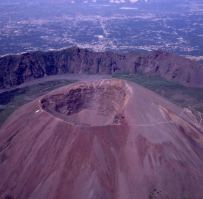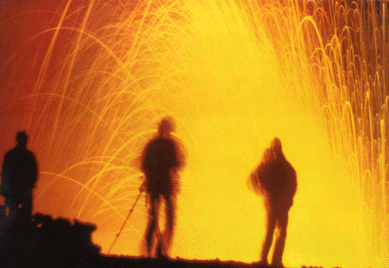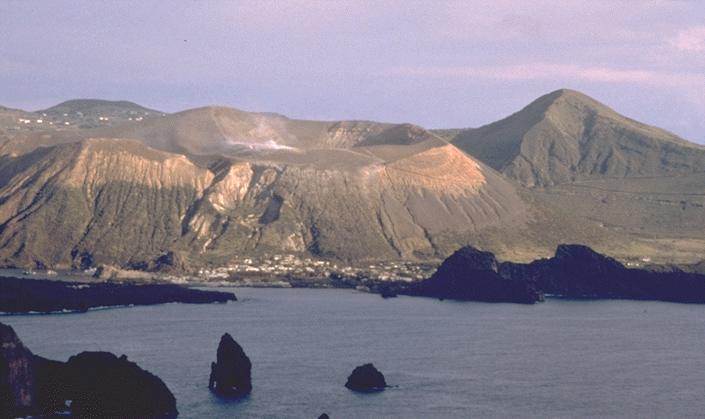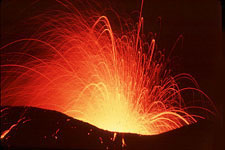-- Italy --
June 4-14, 2004
The volcanoes of southern Italy have always exerted an intense fascination and attraction to the western civilization, and they continue to do so. In spite of their fame, the Italian volcanoes are fairly little known, even by many non-Italian geologists - a result of many errors and misconceptions dispersed in the secondary, scientific and non-scientific literature, or simply lack of precise information. It is known that Italy's volcanoes are particular in many respects. Maybe the most notable is the long historical record of their activity, and the resulting influence on the cultural and social evolution of the populations living around them. More precisely, Italy has the (somewhat questionable) privilege to have the volcano with the highest number of historically documented eruptions of the world (Etna - which is also one of the most active volcanoes of the world), one of the few volcanoes worldwide that erupt many times a day (Stromboli), and what is probably the most dangerous volcano on Earth (Vesuvio). It has been here that the term "volcano" was introduced, derived from the Ancient Roman god of fire Vulcanus. It was at Vesuvio, in A.D. 79, when a young man observed a devastating eruption, which he was to describe later in dramatic detail, thus furnishing the oldest (surviving) eyewitness account of a volcanic eruption. During the 18th and 19th centuries, education of young members of the European high society included a visit to the Italian volcanoes and to the traces of their destruction.
We'll visit 4 volcanoes, 2 of which are likely to be erupting then, as they are now. We'll have an expert guide. Check out the websites!
June 4-14: Italy
| Where | What To Do | Accomodation | ||||
| Day 1 | Naples | Arriving, ev. INGV Naples | Hotel around Vesuvius | |||
| Day 2 | Mt. Vesuvius | Climb the summit | Hotel around Vesuvius | |||
| Day 3 | Pompei/Ercolano | City tour, museums | Ferry to Stromboli |
- Vesuvius has erupted about three dozen times since 79 A.D., most recently from 1913-1944.
____________________
_____________________________source: http://www.vesuvioinrete.it/galleria/a_vulcano1.jpg
| Where | What To Do | Accomodation | ||||
| Day 4 | Stromboli (currently ACTIVE!) | NGV, Climb the volcano | Hotel Stromboli | |||
| Day 5 | Stromboli | Free time | Hotel Stromboli |
- Stromboli is one of the most active volcanoes on Earth. It has been in nearly continuous eruption for about 2,000 years (some volcanologists suggest 5,000 years). Most of the present cone was well developed 15,000 years ago.
 |
| Stromboli: http://volcano.und.nodak.edu/vwdocs/volc_images/img_stromboli.html |
| Where | What To Do | Accomodation | ||||
| Day 6 | LipariVulcano | Vulcanological museum, Climb the Gran Cratere, NGV | Hotel Vulcano |
- Vulcano is a volcanic island and the southernmost of the Aeolian Islands. It is made from several overlapping volcanic centers.
 |
| Vulcano: http://volcano.und.nodak.edu/vwdocs/volc_images/europe_west_asia/vulcano.html |
| Where | What To Do | Accomodation | ||||
| Day 7 | Transfer to Etna | Gole del Alcantara | Rifugio Etna Nord | |||
| Day 8 | Etna Nord | Caves and ERUPTION 2002/03 | Rifugio Etna Nord | |||
| Day 9 | Traversata | Etna summit craters and eruptive sites of 2001 and 2002/03 | Hotel Etna Sud |
- Mt Etna Volcano is one of the world's most active volcanoes. It has
been erupting for over half a million years.
Dormant periods at Mt Etna are extremely rare.
 |
| Etna: http://www.volcanolive.com/etna.html |
| What To Do | ||
| Day 10 | Departure flight back to U.S. |